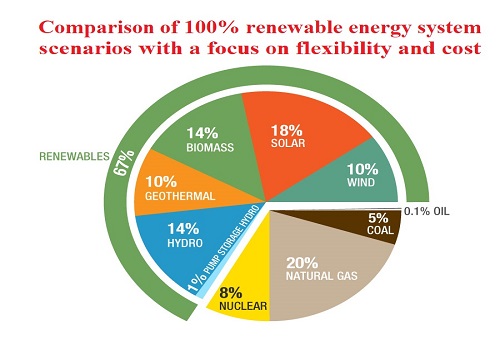Admin
مدير المنتدى


عدد المساهمات : 18996
التقييم : 35494
تاريخ التسجيل : 01/07/2009
الدولة : مصر
العمل : مدير منتدى هندسة الإنتاج والتصميم الميكانيكى
 |  موضوع: بحث بعنوان Comparison of 100% Renewable Energy System Scenarios With a Focus on Flexibility and Cost موضوع: بحث بعنوان Comparison of 100% Renewable Energy System Scenarios With a Focus on Flexibility and Cost  السبت 07 نوفمبر 2020, 2:55 am السبت 07 نوفمبر 2020, 2:55 am | |
| 
أخوانى فى الله
أحضرت لكم بحث بعنوان
Comparison of 100% Renewable Energy System Scenarios With a Focus on Flexibility and Cost
Wesley Deason

و المحتوى كما يلي :
ABSTRACT
In this study, a particular class of energy system scenarios assuming 100% renewable energy (RE) are selected
and compared. The purpose is to compare the relative characteristics of the scenarios, focusing on the amount
and types of flexibility used and the predicted electricity generation cost. The approach included the screening of
45 studies (some of which contained multiple scenarios) to down-select to 8 studies, which used high-fidelity
short-term energy system models. The compared scenarios applied many strategies for providing flexibility,
which was found to be a crucial and significant component of a 100% RE system. Accordingly, only two of the
fifteen examined scenarios contained a variable generation fraction greater than 65% of total scenario capacity
(73% and 69%). Predicted electricity costs varied drastically in all regions. Some studies provided multiple
scenarios (including business-as-usual scenarios and costs) that could be compared. In 3 out of the 4 studies
including a business-as-usual cost, the 100% RE scenarios were found to be between 41% and 104% more
expensive. The fourth study showed electricity costs to be the same for a 100% RE system and business-as-usual
system, and the 100% RE system to be 62% cheaper when externalities are included.
Conclusions
The compared scenarios showed that many different strategies and
technologies can be used to provide flexibility in a 100% RE system. To
complement the variability of electricity generation from variable
generation sources, energy must be generated from a flexible generation source, stored in some fashion, or if possible, demand must be
adjusted. To facilitate comparison of scenarios, the primary energy
production from renewables was grouped in the category ‘Variable
Generation Capacity’, while all other mechanisms supporting flexibility
(generation, storage, flexible demand, etc.) were grouped in the category ‘Capacity for Flexibility’. Together, these two categories compose
the principle category, ‘Total Scenario Capacity’. By including capacities for storage and flexible demand in the total scenario capacity
category, the 100% renewable energy system scenarios can be better
compared with each other and with present day generation capacity.
Flexibility was found to be a crucial and significant component of a
100% RE system. None of the scenarios reviewed in the present work
were able to provide all of their energy using only variable generation
capacity, with only two of the scenarios capable of reaching over 65%
variable generation penetration of total scenario capacity (SRU 2011
Scenarios 1.a and 1.b (Germany) [34] feature 73% and 69% respectively).
Predicted electricity costs from the scenarios varied drastically in all
regions, and from these results, it was not possible to conclusively say
that a 100% RE system from one region is less economic than another.
Each calculated cost is highly dependent upon the specific environment
of each scenario and the cost calculation method used. Lack of information on the specific cost components and methodologies used (e.g.
unit costs for capacity, unit lifetimes, generation statistics, and cost
calculation methods) prevented direct comparison. However, some
studies provided multiple scenarios (including business-as-usual scenarios) that could be compared. In 3 out of the 4 studies including a
business-as-usual cost, the 100% RE scenarios were found to be between 41% and 104% more expensive. The fourth study (Jacobson et al.
[51]) showed electricity costs to be the same for a 100% RE system and
business-as-usual system, and the 100% RE system to be 62% cheaper
when externalities are included.
The scenarios discussed in the present work and the strategies used
in those scenarios are not exhaustive of all scenarios possible in a
decarbonized future. Though not examined in this study, further integration of different energy carriers, usage or markets (e.g. heat and
electricity produced from renewable, nuclear or concentrating solar
thermal sources, transportation, water desalination plants, etc.) will be
needed to achieve full decarbonization. Some renewable technologies
and scenarios discussed in this study may not come to fruition because
of economic barriers or environmental changes, notably due to climatic
changes.
Future work could investigate the role and economic viability of
other low-carbon technologies (nuclear power or fossil with carbon
capture and storage) to operate in a high-penetration RE system as a
flexible generation source. Focus could also be given on the increased
flexibility brought to the energy system through the capability for these
technologies to function as cogeneration systems (providing both useful
heat and electricity on-demand).
Acknowledgements
I would like to acknowledge the United States Department of State
for supporting my Junior Professional Officer position at the
International Atomic Energy Agency. I would also like to acknowledge
my colleagues, Bertrand Magné, Manuel Welsch, Aliki van Heek, and
David Shropshire of the Planning and Economic Studies Section in their
guidance in the development of this project and helpful assistance with
reviewing and improving it.
كلمة سر فك الضغط : books-world.net
The Unzip Password : books-world.net
أتمنى أن تستفيدوا من محتوى الموضوع وأن ينال إعجابكم
رابط من موقع عالم الكتب لتنزيل بحث بعنوان Comparison of 100% Renewable Energy System Scenarios With a Focus on Flexibility and Cost
رابط مباشر لتنزيل بحث بعنوان Comparison of 100% Renewable Energy System Scenarios With a Focus on Flexibility and Cost 
|
|







